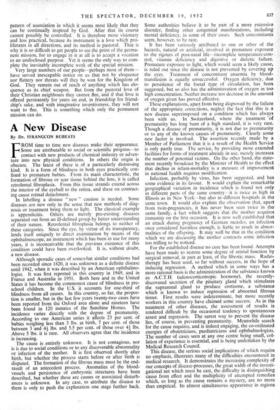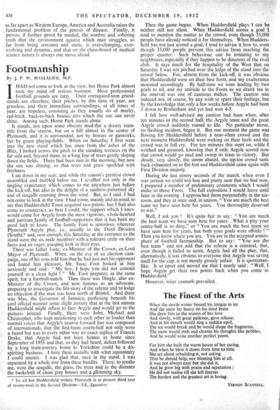A New Disease
By Dr. FFRANGCON ROBERTS
FROM time to time new diseases make their appearance. Some are attributable to social or scientific progress—to contact with new products of chemical industry or adven- ture into new physical conditions. In others the origin is obscure. The latest of these is of a particularly distressing kind. It is a form of blindness in both eyes practically con- fined to premature babies. From its main characteristic, the formation of fibrous or scar tissue behind the lens, it is called retrolental fibroplasia. From this tissue strands extend across the interior of the eyeball to the retina, and these on contract- ing cause retinal detachment.
In labelling a disease - new " caution is needed. Some diseases are new only in the sense that new methods of diag- nosis or treatment bring them to light. The classical example is appendicitis. Others are merely pre-existing diseases separated out from an ill-defined group by better understanding of their nature. Retrolental fibroplasia belongs to neither of these categories. Since the eye, by virtue of its transparency, lends itself uniquely to direct examination by means of the ophthalmoscope, an instrument which has been in use for many years, it is inconceivable that the previous existence of this condition could have been overlooked. It is, without doubt, a new disease.
Although sporadic cases of somewhat similar conditions had been recorded since 1820, it was unknown as a definite disease until 1942, when it was described by an American ophthalmo- logist. It was first reported in this country in 1949, and in France and Australia in 1951. Both here and in the United States it has become the commonest cause of blindness in pre- school children. In the U.S. it accounts for one-third of blindness from all causes. In this country, so far, the propor- tion is smaller, but in the last few years twenty-two cases have been reported from the Oxford area alone and nineteen have been found in 120 inmates of the Sunshine Homes. The incidence varies directly with the degree of prematurity. According to one American series it affects 23 per cent. of babies weighing less than 3 lbs. at birth, 7 per cent. of those between 3 and 41 lbs. and 5.5 per cent. of those over 41 lbs. Above 5 lbs. it is rare. All observers agree that the incidence is increasing. The cause is entirely unknown. it is not contagious, nor is it due to social conditions or to any discoverable abnormality or infection of the mother. It is first observed shortly after birth, but whether the process starts before or after birth is disputed. The formation of the fibrous mass must be the end- result of an antecedent process. Anomalies of the blood- vessels and persistence of embryonic structures have been described, but whether these are causes or associated disturb- ances is unknown. In any case, to attribute the disease to them is only to push the explanation one stage further back. Some authorities believe it to be part of a more extensive disorder, finding other congenital manifestations, including mental deficiency, in some of their cases. Such concomitants seem, however, to be rare.
It has been variously attributed to one or other of the hazards, natural or artificial, involved in premature exposure to the rigours of post-natal life—incomplete temperature-con- trol, vitamin deficiency and digestive or dietetic failure. Premature exposure to light, which would seem a likely cause, is ruled out since the disease is not prevented by covering up the eyes. Treatment of concomitant anaemia by blood- transfusion is equally unsuccessful. Oxygen deficiency, due to persistence of the foetal type of circulation, has been suggested, but so also has the administration of oxygen in too high concentration. Neither increase nor decrease in the amount of oxygen given has proved effective.
These explanations, apart from being disproved by the failure of the appropriate corrections, neglect the fact that this is a , new disease superimposed on a condition which has always been with us. In Switzerland, where the treatment of prematurity has long been of a high standard, it is very rare. Though a disease of prematurity, it is not due to prematurity or to any of the known causes of prematurity. Clearly some new factor is involved. The assertion recently made by a Member of Parliament that it is a result of the Health Service is only partly true. The service, by providing more extended facilities for forms of treatment already in use, merely increases the number of potential victims. On the other hand, the state- ment recently broadcast by the Minister of Health to the effect that decline in infant-mortality is a measure of improvement in national health requires modification.
Infection, probably by virus, has been suggested, and has some evidence in its favour. It would explain the remarkable geographical variation in incidence which is found not only in different parts of the same country—it is twice as high in Illinois as in New York—but also in different hospitals in the same town. It would also explain the observation that, apart from twin-pregnancies, it has never been seen twice in the same family, a fact which suggests that the mother acquires immunity on the first occasion. It is now well established that an attack during pregnancy of German measles, an infection once considered harmless enough, is liable to result in abnor- malities of the offspring. It may well be that in the condition which we are discussing the mother contracts some infection too trifling to be noticed.
For the established disease no cure has been found. Attempts have been made to restore some degree of retinal function by surgical removal, in part at least, of the fibrotic mass. Radio- therapy has been used, so far without success, in the hope of inducing regression. A method which in some ways has a more rational basis is the administration of the substance known as A.C.T.H. (adenocorticotropic hormone), the recently- discovered secretion of the pituitary gland which stimulates the suprarenal gland to produce cortisone, a substance which is known to induce regression of abnormal fibrous tissue. First results were indeterminate, but more recently workers- in this country have claimed some success. As in the treatment of other diseases, the assessment of results is rendered difficult by the occasional tendency to spontaneous arrest and regression. The surest way to prevent the disease lies, of course, in preventing prematurity. Meanwhile search for the cause requires, and is indeed engaging, the co-ordinated energies of obstetricians, paediatricians and ophthalmologists. The number of cases seen at any one centre being small, col- lation of experience is essential, and is being undertaken by the Medical Research Council.
This disease, the serious social implications of which require no emphasis, illustrates many of the difficulties encountered in medical research. It demonstrates the increasing complexity of our concepts of disease-processes, the great width of the investi- gational net which must be cast, the difficulty in distinguishing cause from effect and the multiplicity of attempted remedies which, so long as the cause remains a mystery, are no more than empirical. Its almost simultaneous appearance in regions as far apart as Western Europe, America and Australia raises the fundamental problem of the genesis of disease. Finally, it proves, if further proof be needed, the sombre and sobering truth that the environment against which man struggles, so far from being constant and static, is ever-changing, ever- evolving and dynamic, and that on the chess-board of medical science nature is always one move ahead.



































 Previous page
Previous page